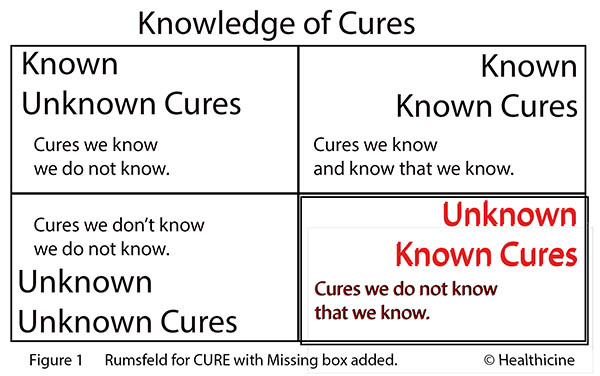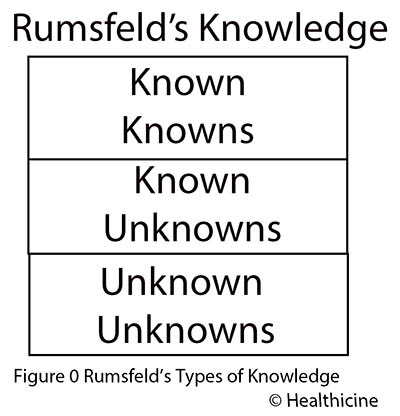How many cures do we know or know of? It’s an interesting question. When we search the labels in our medicine cabinet or our local pharmacy, we might be surprised to learn – there are few, if any ‘cures.’ How many cures do our medical systems recognize? Do the cures we know fit the medical definition of a cure? Do real cures actually occur? What do we know about what we know? On February 12, 2002, Donald Rumsfeld famously said:
“Reports that say that something hasn’t happened are always interesting to me, because as we know, there are known knowns; there are things we know we know. We also know there are known unknowns; that is to say we know there are some things we do not know. But there are also unknown unknowns—the ones we don’t know we don’t know.” Donald Rumsfeld
We can apply this quote to many fields of study. Here, I use it to expand a study of the Theory of Cure, resulting in this quote:
“Reports that say a cure hasn’t happened are always interesting to me because as we know, there are known knowns: there are CURES we know we know. We also know there are known unknowns: that is to say we know there are some CURES we know we do not know. But there are also unknown unknowns—the CURES we don’t know we don’t know.”
The concept quoted by Donald Rumsfeld about known-knowns had been analyzed, deconstructed, and expanded by many. Here, I explore it in relation to cures – that we might learn more about the cures we know and the cures we do not know.
The concepts of ‘knowns’ and ‘unknowns’ – is challenging. Rumsfeld says “there are things we know we know – known knowns.” But, what if some of us know, but some don’t? What if one doctor knows a cure, that is not recognized by others or by our medical systems? There are also many different we’s, who know and know they know, ranging from the royal we (me, myself, and I) to each of the many communities. Different individuals know different things. Each individual lives their life in many communities, which are constantly changing. Different communities of individuals also know different things. Each individual and each community can have different known-knowns, different known-unknowns, and different unknown-unknowns. In general, knowledge held by larger or more authoritative communities can carry more weight, even when incorrect. However, we need constant awareness that what we know, what we know we know – even what the most authoritative community knows it knows, might simply be wrong. As we study knowledge and as we study cures, we need to be constantly aware that what we know, and what we know we know, might be wrong. However, the knowledge that we might be wrong does not stop us from operating intelligently with regard to any subject.
A third issue with Rumsfeld’s quote is the missing set, the unknown-knowns: things we know but don’t know we know. This fourth category, with some variations, has been added by almost everyone who has studied the quote. In the case of cures, I regard unknown-known cures as those that are generally recognized by individuals, even communities, but not documented, not studied by our official medical systems.
Before we map Rumsfeld’s quote to cures, we need to define a cure, to understand what is cured. The word cure is not, at present, scientifically or medically defined. We have no authoritative medical or scientific definition of a cure, cures, curing, nor cured in any current conventional or alternative medical system. Many medical dictionaries simply do not contain an entry for cure. Note: We don’t cure diseases, we cure cases. However, in modern conventional medicine, a testable definition of cured exists only for specific cases of infectious diseases.
Let’s begin with a focus on our medical establishment as the authoritative “we,” while using the healthicine definition of cure because no other comprehensive definition exists. In Healthicine, and in the Theory of Cure, cure is defined as follows:
curable illness: an illness that can be cured
cure: an action (not a drug, not a thing) that addresses the present cause of a case of illness, resulting in a cured state or status. A cure resolves an illness by addressing its present cause, rendering it cured. The illness, not the patient, is cured. There are two fundamental types of cures.
attribute cures: a change to an attribute of diet, body, mind, spirit, community, or environment that cause an illness to be cured. A one-time cure action. Our present medical systems only recognize attribute cures. A cure by medicine or surgery is an attribute transformational cure – a one-time cure. Healing is an attribute cure.
causal cures: a change to a life process of diet, body, mind, spirit, community or environment that must be maintained to maintain the cured status. At present, causal cures are not recognized as cures in any medical system, even though they are common and easily understood.
compound and complex cures: many illnesses have multiple causes and require multiple cures, and many require both an attribute and a causal cure, although this is seldom – if ever – recognized medically. Because compound illnesses have multiple causes and require multiple cures – none can be recognized. Our medical systems insist on simple cures even for complex diseases.
A case of scurvy, for example, might emerge gradually over time as the patient consumes less and less Vitamin C. Scurvy cannot be diagnosed until severe damage has occurred, often after the deficiency has been present for some time. Two cures are required. Supplemental Vitamin C addresses the status cause and promotes the natural transformative power of healing, an attribute cure. But, for the cure to remain, the patient must change their eating habits, their life processes, to consume sufficient Vitamin C for the rest of their lives – lest the disease reoccur. Note: the disease scurvy does not “go into remission” and then re-emerge. It was cured. If the cause occurs again, a new case of scurvy will occur.
Many illnesses, and most diseases, are compound – having multiple causes, and require multiple cures actions. This is true because simple illnesses are easily cured – and the cures are easily ignored. Some illnesses are complex, caused by other illnesses, which might be present or in the past. When an illness causes an illness, both must be cured.
We simplify our knowledge of cure by first analyzing simple cures, curing elementary illnesses, those having a single cause. Even simple illnesses have multiple paths to cure.
I do not mean to say that lemon juice and wine are the only remedies for the scurvy;
this disease, like many others, may be cured by medicines of
very different and opposite qualities to each other.
– James Lind, A Treatise on Scurvy, 1771
Every illness cause has many potential cures. This was clear to James Lind when he discovered the cure for scorbutic status – and is true for every disease known to be curable today. We cannot say that we know “the cure for” any illness, because such a claim excludes the possibility of other cures.
This next image with four boxes illustrates the four domains of knowledge about cures.

I have tried to remain true to Rumsfeld’s quote, with a focus on cure. Similar diagrams have been created in a slightly different fashion by others, for other information domains, for example, Andrea Mantovani and Anh T. Dang each map the first known to awareness, and the second to understanding. This does not exactly match Rumsfeld’s quote. For example, Rumsfeld said “known unknowns: that is to say we know there are some things we know we do not know,”
but these authors converted known unknowns to “things we are aware of but do not understand,” a different concept. These authors arrange the boxes such that moving from left to right and from top to bottom moves to “less knowledge.” However, our natural reading process generally views growth of knowledge or power from left to right and from the bottom to top. As a result, I have intentionally placed the boxes such that moving from bottom to top or from left to right represents an increase in knowledge, an increase in knowing and knowing that we know.
With the above diagram, the concepts are still a bit fuzzy. It’s useful to explore some examples. Can you think of examples to fit in each box?
- this is the first post of a series about the concept of known-known cures. In the next post, I will begin to discuss the knowledge boxes in detail, with examples.
to your health, tracy
Author: A New Theory of Cure



